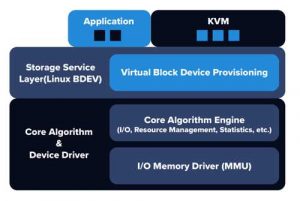Formulus Black Forsa’s Numa Approach Allows Memory and CPU Resources to be Utilized to Their Fullest
Break rules of uniformity to increase performance and persist larger datasets in-memory on existing hardware
This is a Press Release edited by StorageNewsletter.com on July 18, 2019 at 2:39 pmPlaying by the rules of the game designed for traditional CPU and peripheral storage architectures leave today’s multi-processor systems waiting on I/O processes and ‘starving for data,’ effectively minimizing the number of transactions capable of being performed by even the fastest hardware.
Deploying a software approach that enables data to persist on storage media provisioned from DDR and NAND-based memory resources across multiple CPU sockets enables improved performance and in-memory storage capacity, says venture-backed start-up Formulus Black Corporation.
Traditional systems were designed to be synchronous and uniform with processes performed in unison to the ‘ticks and tocks’ of the CPU clock. Traditionally, there is a tradeoff whereby local memory access provides low-latency, high-bandwidth performance while trying to access memory physically residing on other CPU sockets increases latency and reduces performance.
To overcome these limitations, the company developed Forsa to operate on a non-uniform memory access (NUMA) architecture. This architecture allows Forsa to pool and provision memory resources across multiple physical CPU sockets on a single system as high-performance storage devices for the most I/O intensive and latency sensitive applications. By pooling memory across CPUs on a server in this way, Forsa enables larger datasets and application to run in memory than would otherwise be possible on the same server hardware.
“NUMA is a shared memory architecture used in today’s multiprocessing systems that attempts to address the shared memory issue by providing separate memory for each processor, avoiding the performance hit when several processors attempt to address the same memory,” said Pradeep Balakrishnan, head, software development, Formulus Black. “By breaking the inherent rules through a software solution like Forsa, we can enable larger in-memory workloads to run on a single system and at the same time further increase performance-of I/O intensive workloads like OLTP and HTAP databases.“
Read also:
Formulus Black: SQL Performance Records in Benchmark Testings
Forsa enables 22.9 million SQL transactions/mn and sub-microsecond latency on single commodity server by enabling applications to use memory as storage.
May 30, 2019 | Press Release
Formulus Black ForsaOS Unlocking Power of In-Memory Compute for all Applications
Breaks barriers between memory and storage, Linux-based software stack built specifically to run all applications in memory, providing gains in compute efficiency.
March 26, 2019 | Press Release














 Subscribe to our free daily newsletter
Subscribe to our free daily newsletter

